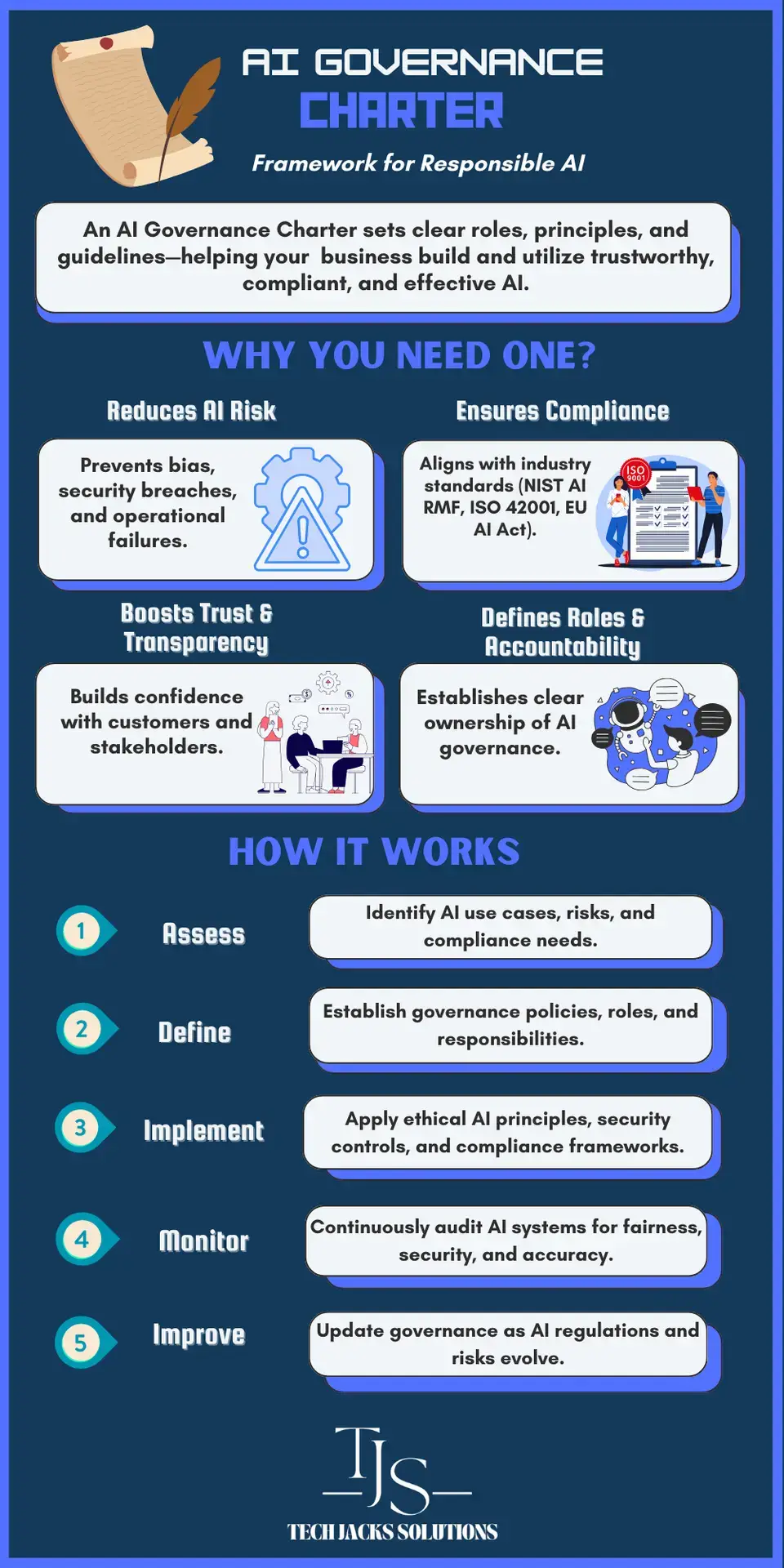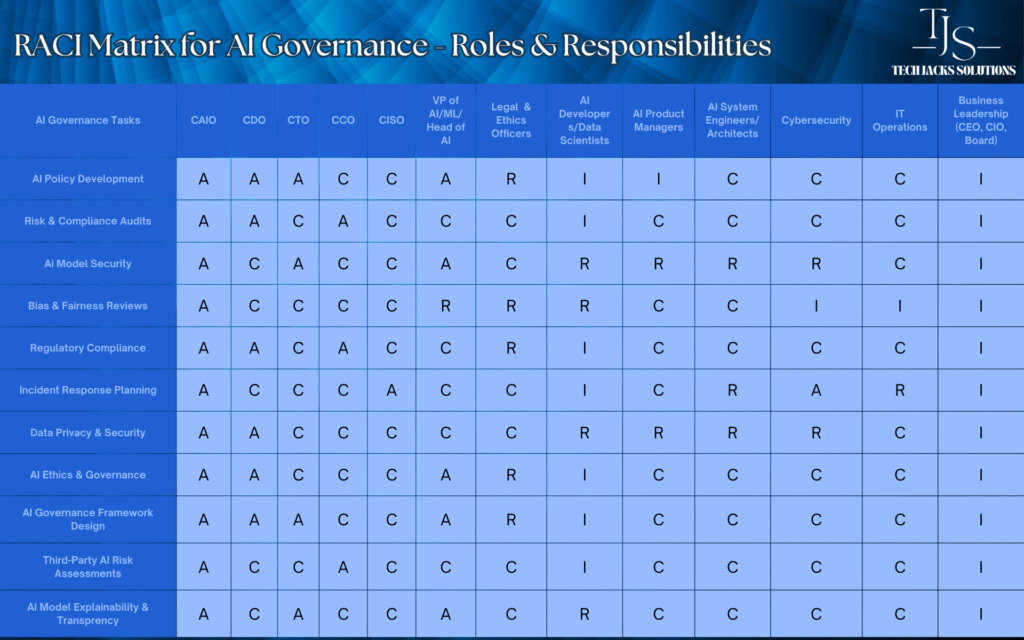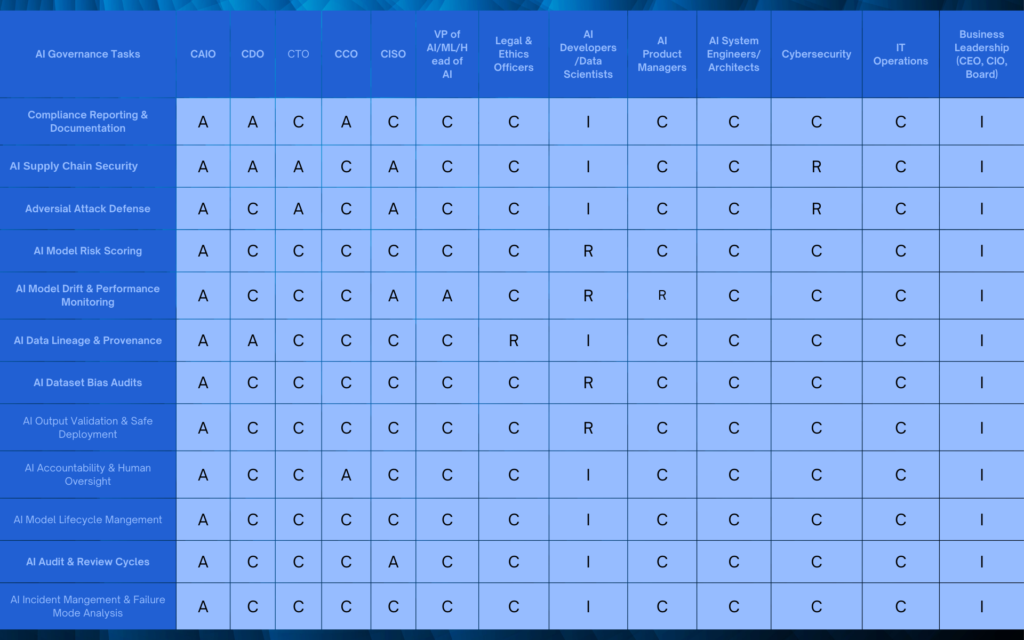Unleashing AI Potential Through Better Governance
Building an AI Governance Committee doesn’t have to be complicated. You need eight steps.
Most companies struggle with AI oversight because they treat it like a technology problem. It’s not. It’s a business problem that needs people from legal, compliance, ethics, security, data science, and operations working together. Your AI Governance Committee becomes an early warning system for bias issues, privacy violations, and security gaps.
NIST, GAO, and CSA publish frameworks that emphasize formalizing AI oversight. Companies without an AI Governance Committee face greater exposure to regulatory and reputational risks. Those with established committees can identify and address issues during regular planning meetings.
The difference comes down to proactive versus reactive management.
A well-structured AI Governance Committee and a defined AI lifecycle speed up value creation. Setting guardrails early (especially around model training, deployment, and monitoring) reduces friction, cuts rework, and lets teams experiment with confidence.
Good governance doesn’t slow you down. It prevents the six-month delays that come from having to rebuild systems after compliance violations.
AI offers competitive advantages, but moving too fast creates regulatory exposure. Racing ahead without oversight is like speeding past a police station. You might gain ground temporarily, but the penalties catch up. An AI Governance Committee lets you move quickly while managing risk. You build trust instead of chaos.
Kicking off by Establishing Objectives
1. Establish the Mandate and Objectives:
The initial and paramount step is to clearly define the purpose, scope, and objectives of the AI Governance Committee. This involves understanding why the committee is being formed and what it is expected to achieve in relation to the organization’s AI initiatives. This stage should also involve obtaining clear support and a mandate from senior leadership and the board of directors, ensuring the committee has the necessary authority to be effective. Defining clear goals and objectives for AI systems themselves will also inform the committee’s priorities. This aligns directly to NIST AI RMF GOVERN principal
2. Define the Committee’s Composition and Roles:
The next critical step is to identify and appoint members to the AI Governance Committee, ensuring a multidisciplinary representation from relevant departments across the organization. This committee should include technical teams (AI Development, IT Security, Data Science), business units, legal and compliance, risk management, and potentially ethics experts and executive leadership Simultaneously, clearly define the roles, responsibilities, and reporting structure of the committee and its members, potentially utilizing a RACI model to ensure accountability and clarity. This includes determining who is responsible for what aspects of AI governance, who is accountable for decisions, who needs to be consulted, and who needs to be informed.

At a High-Level, the 8-steps serve as a guiding outline for the core functions that the AI Committee will oversee. Your organization may not need every function. In fact, your organization may need to create its own unique and business specific functions, so feel free to adjust as needed. This is where an AI Governance Charter can come in helpful, as it can be used to streamline your organizations need based on your own intimate knowledge of business requirements.
Maturing the Committee’s Function
As the Committee becomes more established and the organization’s AI Inventory, Use Cases, and compliance requirements are defined, the need to assess risk increases. Now is the time to ensure that your practices align with both ethical standards and measurable impact.
3. Develop a Responsible AI Framework and Guiding Principles:
A high priority is the creation and approval of a comprehensive Responsible AI framework. This framework should outline the organization’s ethical principles, values, and guidelines for the development and deployment of AI technologies. This should address key areas such as fairness, bias mitigation, transparency, accountability, security, privacy, and societal impact. The AI Governance Committee will likely play a central role in developing and maintaining this framework. This may draw upon existing frameworks and principles like the OECD AI Principles, NIST AI RMF, ISO/IEC 42001 etc.
By referencing widely adopted frameworks, you ensure your policies resonate across diverse teams and keep your AI aligned with global standards.
Without a cohesive framework, your teams might adopt conflicting policies on data privacy or bias mitigation, leading to stalled projects or even public missteps that tarnish your brand
4. Establish Risk Management and Compliance Processes:
Implementing robust risk assessment and risk management methodologies specific to AI is crucial. This step involves identifying, analyzing, and prioritizing AI-related risks across the AI lifecycle. The committee should also establish processes to ensure compliance with relevant laws, regulations, and industry standards. This includes defining security objectives and measurable controls.
If you can’t articulate potential risks upfront (for example, how an AI model might inadvertently discriminate in a lending application), you could face lawsuits or fines after the damage is done.
5. Define Evaluation Criteria and Metrics for AI Systems and Governance
To ensure accountability and effectiveness, the committee needs to establish quantifiable evaluation criteria and key performance indicators (KPIs) for both the AI systems being developed/integrated and the AI governance processes themselves. These metrics will help in assessing the performance, reliability, security, ethical compliance, and overall impact of AI initiatives, as well as the effectiveness of the governance framework.
Tracking metrics like model accuracy, false positives/negatives, or fairness scores can detect performance dips early, preventing costly rollbacks or reputational damage.
Similarly, monitor the governance process itself by measuring how long it takes to review compliance for new AI projects. This keeps your team from getting bogged down in red tape and helps maintain a balance between rapid innovation and proper oversight.

Full Governance Engaged
With a solid framework and defined metrics in place, it’s time to operationalize full-scale governance that covers auditing, specialized controls, and continuous improvement.
6. Implement Audit and Monitoring Mechanisms:
Establishing processes for regular audits of AI systems and governance practices is essential for ongoing oversight and compliance. This includes defining the audit scope, assigning audit ownership, developing audit methodologies, and setting audit metrics.
Furthermore, implementing continuous monitoring and reporting mechanisms for AI system performance, risks, and adherence to policies is vital for early detection of issues and proactive management.
Without scheduled audits and transparent logging, unapproved changes or security gaps can remain hidden, making it harder to detect and address issues before they escalate. Consistent monitoring builds trust with stakeholders: when regulators or senior leadership see robust evidence of oversight, they’re more likely to support new AI initiatives.
7. Address Specific Governance Elements:
Once the foundational elements are in place, the committee can prioritize specific governance elements such as:
Shadow AI Prevention: Implementing measures to identify and govern unauthorized AI systems within the organization.
Data Governance: Focusing on data quality, security, privacy, and ethical use in AI systems.
Model Governance: Establishing policies and procedures for the development, deployment, monitoring, and retirement of AI models. This includes aspects like version control, performance monitoring, and addressing model drift.
Access Control: Implementing mechanisms to manage and restrict access to AI systems, models, and data based on roles and responsibilities.
Output Evaluation and Guardrails: Establishing mechanisms to assess and control the outputs of AI systems to ensure safety, accuracy, and alignment with organizational values.
Third-Party/Supply Chain Management: Developing processes for assessing and managing risks associated with AI vendors and third-party components. This includes vendor assessments, contract management, and dependency monitoring.
Employee Use of GenAI Tools: Establishing policies and guidelines for the responsible and secure use of generative AI tools by employees.
Incident Response: Developing specific plans and procedures for addressing AI-related incidents.
Change Management: Implementing formal processes for managing changes to AI systems
Transparency and Explainability: Ensuring appropriate levels of transparency in AI capabilities and limitations, and striving for explainability of AI outputs where necessary
If shadow AI systems or untracked data sources crop up, your organization risks compliance breaches, ethical lapses, and wasted investment in duplicate or unauthorized projects. Clear guardrails around data usage, model oversight, and third-party risks help maintain consistent standards across teams. They ensure no one goes rogue and jeopardizes the entire AI program.
8. Continuous Improvement and Adaptation:
AI technology and its associated risks are constantly evolving. Therefore, the AI Governance Committee must prioritize continuous monitoring, review, and updating of the AI governance framework, policies, and procedures. This includes staying informed about emerging AI regulations, best practices, and new security threats. Establishing feedback loops with relevant stakeholders is also crucial for ongoing improvement.
Rapid AI advancements mean new vulnerabilities can emerge overnight. If you’re not iterating on policies and best practices, you’ll always be playing catch-up.

Wrapping Up
Developing vs. Consuming AI
While these governance steps apply broadly, keep in mind that organizations creating their own large language models (LLMs) may need deeper controls around data pipelines, model security, and specialized testing for bias. On the other hand, businesses consuming AI services or off-the-shelf models will focus more on vendor due diligence, contractual compliance, and ensuring data fed into these third-party tools meets organizational standards
With these measures, your AI Governance Committee isn’t just reacting to challenges; it’s actively shaping the responsible, ethical, and forward-thinking AI landscape your organization needs.
Please share and/or contact us for consultation to help educate, train, and support your business.
Reference List of Governance Phases & Activities:
| Establish & Mandate Objectives | Define governance mandate, scope, and strategic objectives (Governance Charter). |
| Secure formal endorsement from senior leadership and board members. | |
| Appoint a designated Executive Sponsor (CAIO, CTO, CDO). | |
| Create initial AI Use Case Inventory (foundation for governance). | |
| Conduct introductory training or communication sessions for key stakeholders. | |
| Schedule governance kickoff meeting to establish momentum. | |
| Confirm initial resource allocation and project management structure. | |
| Clearly communicate initial objectives across the organization. | |
| Define the Committee’s Composition and Roles | Identify cross-functional representatives (IT, legal, compliance, ethics, business). |
| Officially appoint governance committee members and document membership. | |
| Publish a detailed RACI Matrix to define responsibilities clearly. | |
| Define meeting cadence and formalize reporting structure. | |
| Confirm committee authority boundaries and escalation paths. | |
| Provide basic committee onboarding and governance orientation. | |
| Launch initial internal communication about committee structure. | |
| Establish mechanism for stakeholder input and engagement. | |
| Develop Responsible AI Framework & Guidance Principals | Publish foundational Responsible AI Policy Document (ethics, fairness, transparency). |
| Draft and distribute AI Acceptable Usage Policy for immediate employee guidance. | |
| Develop standardized documentation (Model Cards, Datasheets) for AI models. | |
| Clearly define AI transparency, fairness, and explainability guidelines. | |
| Conduct employee and stakeholder training on Responsible AI principles. | |
| Develop simplified awareness resources (infographics, FAQs) for employees. | |
| Schedule regular stakeholder feedback sessions to refine policies. | |
| Confirm internal review and approval processes for AI-related documents. | |
| Establish Risk Management & Compliance Process | Implement comprehensive AI Risk Management Framework. |
| Create detailed Regulatory Compliance Matrix aligned with key laws/regulations. | |
| Establish initial AI Risk Register to document identified risks. | |
| Schedule preliminary risk assessments for identified high-risk AI systems. | |
| Integrate NIST AI RMF & CSA guidance into risk and compliance checks. | |
| Identify preliminary security and privacy risks for existing AI projects. | |
| Draft preliminary data-handling and privacy guidelines. | |
| Clearly document risk-assessment responsibilities and roles. | |
| Define Evaluation Criteria and Metrics for AI Systems and Governance | Establish clear, quantifiable governance performance KPIs. |
| Set specific AI system performance metrics (accuracy, fairness, bias mitigation). | |
| Implement a user-friendly, centralized metrics dashboard. | |
| Develop routine reporting mechanisms for governance effectiveness. | |
| Provide simplified training on performance metrics usage. | |
| Define clear responsibilities for metrics tracking and reporting. | |
| Plan periodic metric-review sessions to assess effectiveness. | |
| Define success criteria for governance program at key milestones. | |
| Implement Audit and Monitoring Mechanism | Develop structured audit plans aligned with GAO & CSA guidelines. |
| Launch simple yet effective continuous monitoring tools. | |
| Publish clear auditing procedures (internal/external audits, checks). | |
| Provide accessible audit reports highlighting key findings and action items. | |
| Schedule regular audit feedback and improvement sessions. | |
| Create clear accountability for responding to audit recommendations. | |
| Establish tracking and escalation mechanisms for unresolved audit items. | |
| Integrate monitoring data into continuous improvement processes. | |
| Address Specific Governance Elements | Regularly update and expand AI Use Case Inventory. |
| Maintain a central, easily accessible Runbook/Playbook Library. | |
| Document clear Incident Response Protocols specific to AI issues. | |
| Implement Shadow AI detection and governance procedures. | |
| Develop guidelines for employee usage of Generative AI tools. | |
| Document clear policies for third-party AI vendor assessments. | |
| Provide ongoing communication and training on specific governance areas. | |
| Establish clear accountability for managing specific governance elements. | |
| Continous Improvement and Adaption | Set up robust, ongoing stakeholder feedback channels. |
| Conduct regular, formal governance review meetings (quarterly recommended). | |
| Perform structured annual AI Governance Maturity Assessments. | |
| Regularly revise governance framework to align with emerging standards (OECD, NIST). | |
| Document lessons learned and integrate them into improvement cycles. | |
| Clearly define governance review roles and escalation paths. | |
| Develop training programs to adapt to new regulations or best practices. | |
| Publish periodic governance progress reports to maintain transparency. |





